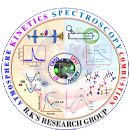Rate coefficients for the reactions of Cl atoms with isopropyl formate (IPF) and isobutyl formate (IBF) were measured experimentally over the temperature range of 268–363 K and at 760 Torr of nitrogen using relative rate method. Ethyl acetate and ethyl formate were used as reference compounds for the measurement of rate coefficients for the reaction of IPF with Cl atoms. Ethane and ethylene were used as reference compounds for the measurement of rate coefficients for the reaction of IBF with Cl atoms. The obtained rate coefficients for the reactions of IPF and IBF with Cl atoms at 298 K are (1.56 ± 0.47) × 10–11 and (7.60 ± 1.10) × 10–11 cm3 molecule–1 s–1 respectively. The derived temperature dependent Arrhenius expression for the reactions of IPF and IBF with Cl atoms are kR1(268–363K)Experimental = (3.87 ± 0.88) × 10–12 exp [(418 ± 70)/T] and kR2(268–363K)Experimental = (1.83 ± 0.45) × 10–11 exp [(421 ± 70)/T] cm3 molecule–1 s–1 respectively. A qualitative analysis of the products formed during the reactions of Cl atoms with IPF and IBF were carried out using gas chromatography–mass spectrometry (GC–MS) and gas chromatography–infrared spectroscopy (GC–IR) as analytical tools, and the degradation mechanisms were proposed on the basis of end products. To rationalize our experimentally obtained results, computational calculations were performed to calculate the temperature dependent rate coefficients for these reactions over the temperature range of 200–400 K at CCSD(T)/cc-pVDZ//MP2/6-31+G(d, p) level of theory using canonical variational transition state theory (CVT) with small curvature tunneling (SCT). Detailed discussions on the thermochemistry of the reactions, branching ratios, and atmospheric implications are discussed in the manuscript.
-
Call
-
E-mail
Journal Details
1. Gas Phase Kinetics and Mechanistic Insights for the Reactions of Cl atoms with Isopropyl Formate and Isobutyl Formate.
A. Kumar and B. Rajakumar, J. Phys. Chem, , 9978-9994, 123
